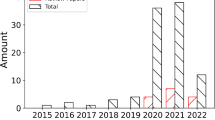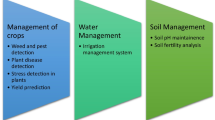Abstract
The evolution in science and innovation has to lead to an immense volume of information from various agricultural fields to be accumulated in the public domain. As a result, an objective arises from the investigation of the accessible information and incorporating them with processes like foreseeing crop yield, plant diseases examination, crops enhancement, etc. Machine learning has grown with tremendous processing methods to conceive new innovations in the multi-disciplinary agricultural sector. In experimenting with machine learning models, there exist certain limitations like improvident nonlinear mapping between the raw data and crop yield values. Hence, deep learning models are comprehensively used to extricate critical crop parameters for prediction. Foreseeing the crop yield depending on climate, soil and water parameters has been a potential research subject. This paper proposes a hybrid deep learning-based crop yield prediction system using deep belief network (DBN) and fuzzy neural networks system (FNN). DBN is a combination of statistics and probability with neural networks. Though DBN performs better for nonlinear systems, the algorithm alone cannot provide satisfactory results in terms of robustness, model accuracy and learning speed, which is predominantly due to gradient diffusion. Hence, a DBN along with FNN has been proposed to overcome the nonlinearity and gradient diffusion problems. The proposed model initially performs an efficient pre-training technique by DBN for enhanced model development and feature vector generation. This characteristic feature vector is fed as an input to the FNN for further processing. The superiority of the proposed fuzzy neural network-based deep belief network is analyzed by comparing it with other deep learning algorithms. The proposed model efficiently predicts the results outperforming the other models by preserving the original data distribution with an accuracy of 92%.








Similar content being viewed by others
References
Valin H, Sands RD, van der Mensbrugghe D, Nelson GC, Ahammad H, Blanc E, Bodirsky B, Fujimori S, Hasegawa T, Havlik P, Heyhoe E, Kyle P, Mason D’Croz D, Paltsev S, Rolinski S, Tabeau A, van Meijl H, von Lampe M, Willenbockel D (2014) The future of food demand: understanding differences in global economic models. Agric Econ 45:51–67
Patrício DI, Rieder R (2018) Computer vision and artificial intelligence in precision agriculture for grain crops: a systematic review. Comput Electron Agric 153:69–81
Bruno B, Cammarano D, Carfagna E (2013) Review of crop yield forecasting methods and early warning systems. In: Proceedings of the first meeting of the scientific advisory committee of the global strategy to improve agricultural and rural statistics, Vol. 41
Jin X, Zhao K, Ji J, Qiu Z, He Z, Ma H (2018) Design and experiment of intelligent monitoring system for vegetable fertilizing and sowing. J Supercomput pp 1–17
Elavarasan D, Vincent DR, Sharma V, Zomaya AY, Srinivasan K (2018) Forecasting yield by integrating agrarian factors and machine learning models: a survey. Comput Electron Agric 155:257–282
Hund L, Schroeder B, Rumsey K, Huerta G (2018) Distinguishing between model—and data-driven inferences for high reliability statistical predictions. Reliab Eng Syst Saf 180:201–210
Xing Lu, Li L, Gong J, Ren C, Liu J, Chen H (2018) Daily soil temperatures predictions for various climates in United States using data-driven model. Energy 160:430–440
Kaya A, Keceli AS, Catal C, Yalic HY, Temucin H, Tekinerdogan B (2019) Analysis of transfer learning for deep neural network based plant classification models. Comput Electron Agric 158:20–29
Elavarasan D, Vincent PMD (2020a) Crop yield prediction using deep reinforcement learning model for sustainable agrarian applications. IEEE Access 8:86886–86901
Elavarasan D, Vincent DR (2020b) Reinforced XGBoost machine learning model for sustainable intelligent agrarian applications. J Intell Fuzzy Syst 39(5):7605–7620
Bengio Y, Courville A, Vincent P (2013) Representation learning: a review and new perspectives. IEEE Trans Pattern Anal Mach Intell 35(8):1798–1828
Schmidhuber J (2015) Deep learning in neural networks: an overview. Neural Netw 61:85–117
Qiao J, Wang G, Li X, Li W (2018) A self-organizing deep belief network for nonlinear system modelling. Appl Soft Comput 65:170–183
Ali A, Yangyu F (2017) Automatic modulation classification using deep learning based on sparse autoencoders with nonnegativity constraints. IEEE Signal Process Lett 24(11):1626–1630
Ding S, Su C, Yu J (2011) An optimizing BP neural network algorithm based on genetic algorithm. Artif Intell Rev 36:153–162
Chen CLP, Zhang C, Chen L, Gan M (2015) Fuzzy restricted boltzmann machine for the enhancement of deep learning. IEEE Trans Fuzzy Syst 23(6):2163–2173
Islam MA, Anderson DT, Pinar A, Havens TC, Scott G, Keller JM (2019) enabling explainable fusion in deep learning with fuzzy integral neural networks. IEEE Trans Fuzzy Syst
Sarabakha A, Kayacan E (2019) Online deep fuzzy learning for control of nonlinear systems using expert knowledge. IEEE Trans Fuzzy Syst
Samsonovich AV (2019) Socially emotional brain-inspired cognitive architecture framework for artificial intelligence. Cognit Syst Res 60:57–76
Ryan K, Agrawal P, Franklin S (2019) The pattern theory of self in artificial general intelligence: a theoretical framework for modeling self in biologically inspired cognitive architectures. Cognit Syst Res 62:44–56
Wason R (2018) Deep learning: evolution and expansion. Cogn Syst Res 52:701–708
Moreno R, Corona F, Lendasse A, Graña M, Galvão LS (2014) Extreme learning machines for soybean classification in remote sensing hyperspectral images. Neurocomputing 128:207–216
Zhang S, Huang W, Zhang C (2019) Three-channel convolutional neural networks for vegetable leaf disease recognition. Cogn Syst Res 53:31–41
Zhu X, Zhu M, Ren H (2018) Method of plant leaf recognition based on improved deep convolutional neural network. Cogn Syst Res 52:223–233
Nevavuori P, Narra N, Lipping T (2019) Crop yield prediction with deep convolutional neural networks. Comput Electron Agric 163:104859
Haghverdi A, Washington-Allen RA, Leib BG (2018) Prediction of cotton lint yield from phenology of crop indices using artificial neural networks. Comput Electron Agric 152:186–197. https://doi.org/10.1016/j.compag.2018.07.021
Abrougui K, Gabsi K, Mercatoris B, Khemis C, Amami R, Chehaibi S (2019) Prediction of organic potato yield using tillage systems and soil properties by artificial neural network (ANN) and multiple linear regressions (MLR). Soil Tillage Res 190:202–208
Byakatonda J, Parida BP, Kenabatho PK, Moalafhi DB (2018) Influence of climate variability and length of rainy season on crop yields in semiarid Botswana. Agric Forest Meteorol 248:130–144
Chen S, Li B, Cao J, Mao Bo (2018) Research on agricultural environment prediction based on deep learning. Procedia Comput Sci 139:33–40
Kounalakis T, Triantafyllidis GA, Nalpantidis L (2019) Deep learning-based visual recognition of rumex for robotic precision farming. Comput Electron Agric 165:104973
dos Santos Ferreira A, Freitas DM, da Silva GG, Pistori H, Folhes MT (2019) Unsupervised deep learning and semi-automatic data labeling in weed discrimination. Comput Electron Agric 165:104963
Yang L, Yi S, Zeng N, Liu Y, Zhang Y (2017) Identification of rice diseases using deep convolutional neural networks. Neurocomputing 267:378–384
Lee SH, Goëau H, Bonnet P, Joly A (2020) New perspectives on plant disease characterization based on deep learning. Comput Electron Agric 170:105220
Thenmozhi K, Reddy US (2019) Crop pest classification based on deep convolutional neural network and transfer learning. Comput Electron Agric 164:104906. https://doi.org/10.1016/j.compag.2019.104906
Acknowledgment
We thank the India water portal for providing the meteorological data relevant to climatic factors from their MET data tool. The MET data tool provides district wise monthly and the annual mean of each metrological indicator values. We also thank the Joint Director of Agriculture, Vellore, Tamil Nadu, India, for providing the details regarding the soil and groundwater properties for the respective village blocks.
Author information
Authors and Affiliations
Contributions
This research specifies below the individual contributions. DE Conceptualization, Methodology, Software, Validation, Formal analysis and Investigation, Writing—Original draft preparation, Visualization. PMDRV: Conceptualization, Validation, Writing—Review and Editing, Supervision.
Corresponding author
Ethics declarations
Conflict of interest
This manuscript has not been submitted to, nor is under review at, another journal or other publishing venue. The authors have no affiliation with any organization with a direct or indirect financial interest in the subject matter discussed in the manuscript. The authors declare that they have no known competing financial interests or personal relationships that could have appeared to influence the work reported in this paper.
Additional information
Publisher's Note
Springer Nature remains neutral with regard to jurisdictional claims in published maps and institutional affiliations.
Rights and permissions
About this article
Cite this article
Elavarasan, D., Durai Raj Vincent, P.M. Fuzzy deep learning-based crop yield prediction model for sustainable agronomical frameworks. Neural Comput & Applic 33, 13205–13224 (2021). https://doi.org/10.1007/s00521-021-05950-7
Received:
Accepted:
Published:
Issue Date:
DOI: https://doi.org/10.1007/s00521-021-05950-7




